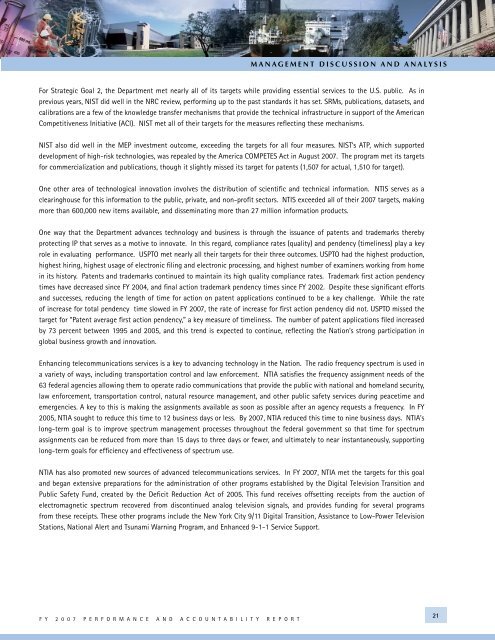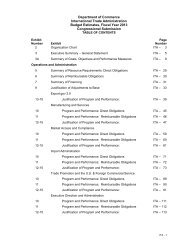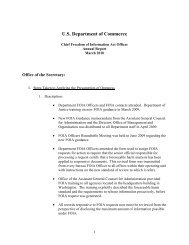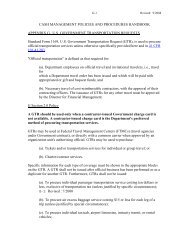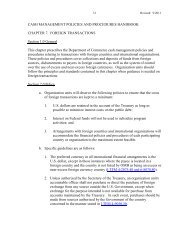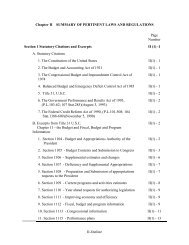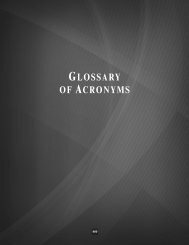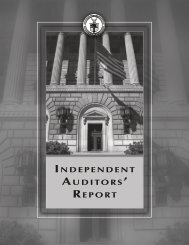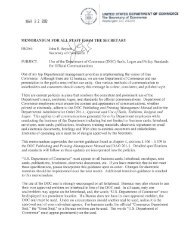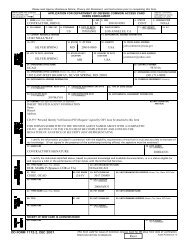United States DEPARTMENT of Commerce
United States DEPARTMENT of Commerce
United States DEPARTMENT of Commerce
You also want an ePaper? Increase the reach of your titles
YUMPU automatically turns print PDFs into web optimized ePapers that Google loves.
A P P E N D I X A : P E R F O R M A N C E A N D R E S O U R C E T A B L E S<br />
M a n a g e m e n t D i s c u s s i o n a n d A n a l y s i s<br />
For Strategic Goal 2, the Department met nearly all <strong>of</strong> its targets while providing essential services to the U.S. public. As in<br />
previous years, NIST did well in the NRC review, performing up to the past standards it has set. SRMs, publications, datasets, and<br />
calibrations are a few <strong>of</strong> the knowledge transfer mechanisms that provide the technical infrastructure in support <strong>of</strong> the American<br />
Competitiveness Initiative (ACI). NIST met all <strong>of</strong> their targets for the measures reflecting these mechanisms.<br />
NIST also did well in the MEP investment outcome, exceeding the targets for all four measures. NIST’s ATP, which supported<br />
development <strong>of</strong> high-risk technologies, was repealed by the America COMPETES Act in August 2007. The program met its targets<br />
for commercialization and publications, though it slightly missed its target for patents (1,507 for actual, 1,510 for target).<br />
One other area <strong>of</strong> technological innovation involves the distribution <strong>of</strong> scientific and technical information. NTIS serves as a<br />
clearinghouse for this information to the public, private, and non-pr<strong>of</strong>it sectors. NTIS exceeded all <strong>of</strong> their 2007 targets, making<br />
more than 600,000 new items available, and disseminating more than 27 million information products.<br />
One way that the Department advances technology and business is through the issuance <strong>of</strong> patents and trademarks thereby<br />
protecting IP that serves as a motive to innovate. In this regard, compliance rates (quality) and pendency (timeliness) play a key<br />
role in evaluating performance. USPTO met nearly all their targets for their three outcomes. USPTO had the highest production,<br />
highest hiring, highest usage <strong>of</strong> electronic filing and electronic processing, and highest number <strong>of</strong> examiners working from home<br />
in its history. Patents and trademarks continued to maintain its high quality compliance rates. Trademark first action pendency<br />
times have decreased since FY 2004, and final action trademark pendency times since FY 2002. Despite these significant efforts<br />
and successes, reducing the length <strong>of</strong> time for action on patent applications continued to be a key challenge. While the rate<br />
<strong>of</strong> increase for total pendency time slowed in FY 2007, the rate <strong>of</strong> increase for first action pendency did not. USPTO missed the<br />
target for “Patent average first action pendency,” a key measure <strong>of</strong> timeliness. The number <strong>of</strong> patent applications filed increased<br />
by 73 percent between 1995 and 2005, and this trend is expected to continue, reflecting the Nation’s strong participation in<br />
global business growth and innovation.<br />
Enhancing telecommunications services is a key to advancing technology in the Nation. The radio frequency spectrum is used in<br />
a variety <strong>of</strong> ways, including transportation control and law enforcement. NTIA satisfies the frequency assignment needs <strong>of</strong> the<br />
63 federal agencies allowing them to operate radio communications that provide the public with national and homeland security,<br />
law enforcement, transportation control, natural resource management, and other public safety services during peacetime and<br />
emergencies. A key to this is making the assignments available as soon as possible after an agency requests a frequency. In FY<br />
2005, NTIA sought to reduce this time to 12 business days or less. By 2007, NTIA reduced this time to nine business days. NTIA’s<br />
long-term goal is to improve spectrum management processes throughout the federal government so that time for spectrum<br />
assignments can be reduced from more than 15 days to three days or fewer, and ultimately to near instantaneously, supporting<br />
long-term goals for efficiency and effectiveness <strong>of</strong> spectrum use.<br />
NTIA has also promoted new sources <strong>of</strong> advanced telecommunications services. In FY 2007, NTIA met the targets for this goal<br />
and began extensive preparations for the administration <strong>of</strong> other programs established by the Digital Television Transition and<br />
Public Safety Fund, created by the Deficit Reduction Act <strong>of</strong> 2005. This fund receives <strong>of</strong>fsetting receipts from the auction <strong>of</strong><br />
electromagnetic spectrum recovered from discontinued analog television signals, and provides funding for several programs<br />
from these receipts. These other programs include the New York City 9/11 Digital Transition, Assistance to Low-Power Television<br />
Stations, National Alert and Tsunami Warning Program, and Enhanced 9-1-1 Service Support.<br />
F Y 2 0 0 7 P E R F O R M A N C E A N D A C C O U N T A B I L I T Y R E P O R T<br />
21


